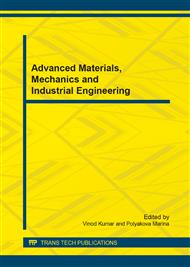[1]
Reg Austin, Unmanned Aircraft Systems: UAVS Design, Development and Deployment, John Wiley & Sons, (2011).
Google Scholar
[2]
Haiyang Chao, YangQuan Chen, Remote Sensing and Actuation Using Unmanned Vehicles, John Wiley & Sons, (2012).
Google Scholar
[3]
Young-Rae Kim, Small Unmanned Aerial Vehicle (S-UAV) Study for Civilian Applications, Massachusetts Institute of Technology, Department of Aeronautics and Astronautics, (1998).
Google Scholar
[4]
Seungho Jeong, Seul Jung, Position Control of a Quad-Rotor System.
Google Scholar
[5]
Yogianandh Naidoo, Riaan Stopforth and Glen Bright, Quad-Rotor Unmanned Aerial Vehicle Helicopter Modelling & Control.
DOI: 10.5772/45710
Google Scholar
[6]
Atheer L. Salih, M. Moghavvemi, Haider A. F. Mohamed et al, Flight PID controller design for a UAV quadrotor, Scientific Research and Essays Vol. 5(23), pp.3660-3667, 4 December, (2010).
Google Scholar
[7]
Sergio Salazar, Hugo Romero, et al, Real-time Stereo Visual Servoing Control of an UAV having Eight-Rotors.
DOI: 10.1109/iceee.2009.5393423
Google Scholar
[8]
S. Bouabdallah and R. Siegwart, Backstepping and Sliding-mode Techniques Applied to an Indoor Micro Quadrotor,, inProc. of the IEEE International Conference on Robotics and Automation, Barcelona, Spain, apr 2005, p.2247–2252.
DOI: 10.1109/robot.2005.1570447
Google Scholar
[9]
A. Tayebi and S. McGilvray, Attitude stabilization of a four-rotor aerial robot, in Proc. of the IEEE Conference on Decision and Control, Atlantis, Paradise Island, Bahamas, dec 2004, p.1216–1221.
DOI: 10.1109/cdc.2004.1430207
Google Scholar
[10]
D.M.W. Abeywardena, L.A.K. Amaratunga, S.A.A. Shakoor and S.R. Munasinghe, A Velocity Feedback Fuzzy Logic Controller for StableHoveringofaQuadRotorVAV, FourthIntemational Conference on Industrial and Information Systems, IClIS 2009, 28-31 December 2009, Sri Lanka.
DOI: 10.1109/iciinfs.2009.5429800
Google Scholar
[11]
Theerasak Sangyam, Pined Laohapiengsak, Wonlop Chongcharoen, et al, Path Tracking of UAV Using Self-Tuning PID Controller Based on Fuzzy Logic, SICE Annual Conference (2010).
Google Scholar
[12]
M. Imran Rashid and Suhail Akhtar, Adaptive Control of a Quadrotor with Unknown Model Parameters, Proceedings of 2012 9th International Bhurban Conference on Applied Sciences & Technology (IBCAST).
DOI: 10.1109/ibcast.2012.6177518
Google Scholar
[13]
P. Castillo, A. Dzul, and R. Lozano, Real-time stabilization and tracking of a four rotor mini rotorcraft, IEEE Transactions on Control Systems Technology, vol. 12, pp.510-516, (2004).
DOI: 10.1109/tcst.2004.825052
Google Scholar
[14]
David Lara, Gerardo Romero, Ramiro Ibarra, Anand Sánchez, Claude Pegard, Onboard system for flight control of a small UAV, Proceedings of the World Automation Congress 2012, Puerto Vallarta, Jalisco, México, pp.1-6.
Google Scholar


